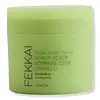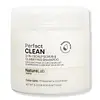Fekkai Apple Cider Detox Scrub Versus NatureLab Tokyo Perfect Clean 2-In-1 Scalp Scrub & Clarifying Shampoo
What's inside
What's inside
 Key Ingredients
Key Ingredients

 Benefits
Benefits

 Concerns
Concerns

 Ingredients Side-by-side
Ingredients Side-by-side

Water
Skin ConditioningCetearyl Alcohol
EmollientOryza Sativa Powder
Brassicamidopropyl Dimethylamine
Skin ConditioningBehentrimonium Chloride
PreservativeBrassica Alcohol
EmollientCetyl Esters
EmollientTriheptanoin
Skin ConditioningZingiber Officinale Root Powder
Skin ConditioningPyrus Malus Fruit Extract
Skin ConditioningVinegar
Piper Nigrum Fruit Powder
Skin ConditioningCetyl Alcohol
EmollientBrassicyl Valinate Esylate
EmollientJojoba Esters
EmollientHydrogenated Ethylhexyl Olivate
EmollientGlycerin
HumectantPropanediol
SolventTrehalose
HumectantPelvetia Canaliculata Extract
Skin ProtectingHelianthus Annuus Seed Wax
Skin ConditioningLeptospermum Scoparium Branch/Leaf Oil
TonicPanthenol
Skin ConditioningMagnolia Officinalis Bark Extract
AntimicrobialEpilobium Angustifolium Flower/Leaf/Stem Extract
Skin ConditioningZingiber Officinale Root Extract
MaskingPhaeodactylum Tricornutum Extract
HumectantLavandula Angustifolia Flower Extract
CleansingSalvia Hispanica Seed Extract
EmollientRosmarinus Officinalis Leaf Extract
AntimicrobialLeontopodium Alpinum Extract
Skin ConditioningPiper Nigrum Seed Extract
RefreshingCaesalpinia Spinosa Fruit Extract
Skin ProtectingHelianthus Annuus Sprout Extract
Skin ConditioningHelianthus Annuus Extract
EmollientHydrolyzed Vegetable Protein
Skin ConditioningOryza Sativa Seed Protein
AntioxidantOryza Sativa Extract
AbsorbentOryza Sativa Bran Extract
Skin ConditioningGuar Hydroxypropyltrimonium Chloride
Skin ConditioningXylitol
HumectantHydrogenated Olive Oil Unsaponifiables
EmollientArginine PCA
HumectantSalicylic Acid
MaskingTocopherol
AntioxidantMaltodextrin
AbsorbentGluconolactone
Skin ConditioningGalactaric Acid
Calcium Gluconate
HumectantPolyglycerin-3
HumectantCaprylyl Glucoside
CleansingPolysorbate 60
EmulsifyingOctyldodecanol
EmollientSorbitan Oleate
EmulsifyingEthyl Linoleate
EmollientEthyl Oleate
EmollientPolyquaternium-37
Potassium Sorbate
PreservativeSodium Benzoate
MaskingSorbic Acid
PreservativeBenzoic Acid
MaskingSodium Phosphate
BufferingPhytic Acid
Caprylic Acid
CleansingEthylhexylglycerin
Skin ConditioningBenzyl Alcohol
PerfumingChlorphenesin
AntimicrobialCaprylyl Glycol
EmollientPhenoxyethanol
PreservativeParfum
MaskingSodium Metabisulfite
AntioxidantC13-16 Isoparaffin
SolventCitric Acid
BufferingPotassium Hydroxide
BufferingLimonene
PerfumingLinalool
PerfumingCitronellol
PerfumingPentaerythrityl Tetra-Di-T-Butyl Hydroxyhydrocinnamate
AntioxidantWater, Cetearyl Alcohol, Oryza Sativa Powder, Brassicamidopropyl Dimethylamine, Behentrimonium Chloride, Brassica Alcohol, Cetyl Esters, Triheptanoin, Zingiber Officinale Root Powder, Pyrus Malus Fruit Extract, Vinegar, Piper Nigrum Fruit Powder, Cetyl Alcohol, Brassicyl Valinate Esylate, Jojoba Esters, Hydrogenated Ethylhexyl Olivate, Glycerin, Propanediol, Trehalose, Pelvetia Canaliculata Extract, Helianthus Annuus Seed Wax, Leptospermum Scoparium Branch/Leaf Oil, Panthenol, Magnolia Officinalis Bark Extract, Epilobium Angustifolium Flower/Leaf/Stem Extract, Zingiber Officinale Root Extract, Phaeodactylum Tricornutum Extract, Lavandula Angustifolia Flower Extract, Salvia Hispanica Seed Extract, Rosmarinus Officinalis Leaf Extract, Leontopodium Alpinum Extract, Piper Nigrum Seed Extract, Caesalpinia Spinosa Fruit Extract, Helianthus Annuus Sprout Extract, Helianthus Annuus Extract, Hydrolyzed Vegetable Protein, Oryza Sativa Seed Protein, Oryza Sativa Extract, Oryza Sativa Bran Extract, Guar Hydroxypropyltrimonium Chloride, Xylitol, Hydrogenated Olive Oil Unsaponifiables, Arginine PCA, Salicylic Acid, Tocopherol, Maltodextrin, Gluconolactone, Galactaric Acid, Calcium Gluconate, Polyglycerin-3, Caprylyl Glucoside, Polysorbate 60, Octyldodecanol, Sorbitan Oleate, Ethyl Linoleate, Ethyl Oleate, Polyquaternium-37, Potassium Sorbate, Sodium Benzoate, Sorbic Acid, Benzoic Acid, Sodium Phosphate, Phytic Acid, Caprylic Acid, Ethylhexylglycerin, Benzyl Alcohol, Chlorphenesin, Caprylyl Glycol, Phenoxyethanol, Parfum, Sodium Metabisulfite, C13-16 Isoparaffin, Citric Acid, Potassium Hydroxide, Limonene, Linalool, Citronellol, Pentaerythrityl Tetra-Di-T-Butyl Hydroxyhydrocinnamate
Sucrose
HumectantGlycerin
HumectantSodium C14-16 Olefin Sulfonate
CleansingCocamide Mea
EmulsifyingGlycol Distearate
EmollientWater
Skin ConditioningRicinus Communis Seed Oil
MaskingSaccharomyces/Rice Extract Ferment Filtrate
Skin ConditioningButyrospermum Parkii Butter
Skin ConditioningCocos Nucifera Oil
MaskingMelaleuca Alternifolia Leaf Oil
AntioxidantVitis Vinifera Fruit Extract
Skin ConditioningArgania Spinosa Callus Culture Extract
Skin ConditioningMalus Domestica Fruit Cell Culture Extract
Skin ConditioningGlutamic Acid
HumectantSodium PCA
HumectantHydrolyzed Coix Lacryma-Jobi Ma-Yuen Seed
HumectantPlatinum Powder
AbrasiveTrigonella Foenum-Graecum Hydroxypropyltrimonium Chloride
Skin ConditioningLocust Bean Hydroxypropyltrimonium Chloride
Skin ConditioningSodium Hyaluronate
HumectantHydroxypropyltrimonium Hyaluronate
Prunus Domestica Seed Extract
EmollientArgania Spinosa Kernel Oil
EmollientLupinus Albus Seed Oil
Skin ConditioningMangifera Indica Seed Oil
EmollientTheobroma Grandiflorum Seed Butter
Skin ConditioningAdansonia Digitata Seed Oil
EmollientCarapa Guaianensis Seed Oil
Skin ConditioningSclerocarya Birrea Seed Oil
HumectantArgan Oil Polyglyceryl-6 Esters
EmollientSodium Glycinate
Skin ConditioningPropanediol
SolventCocamidopropyl Betaine
CleansingButylene Glycol
HumectantGuar Hydroxypropyltrimonium Chloride
Skin ConditioningIsomalt
HumectantXanthan Gum
EmulsifyingPolysorbate 80
EmulsifyingCitric Acid
BufferingSodium Citrate
BufferingTrisodium Phosphate
BufferingSodium Chloride
MaskingLecithin
EmollientBHT
AntioxidantSodium Gluconate
Skin ConditioningPhenoxyethanol
PreservativeSodium Benzoate
MaskingParfum
MaskingLinalool
PerfumingSucrose, Glycerin, Sodium C14-16 Olefin Sulfonate, Cocamide Mea, Glycol Distearate, Water, Ricinus Communis Seed Oil, Saccharomyces/Rice Extract Ferment Filtrate, Butyrospermum Parkii Butter, Cocos Nucifera Oil, Melaleuca Alternifolia Leaf Oil, Vitis Vinifera Fruit Extract, Argania Spinosa Callus Culture Extract, Malus Domestica Fruit Cell Culture Extract, Glutamic Acid, Sodium PCA, Hydrolyzed Coix Lacryma-Jobi Ma-Yuen Seed, Platinum Powder, Trigonella Foenum-Graecum Hydroxypropyltrimonium Chloride, Locust Bean Hydroxypropyltrimonium Chloride, Sodium Hyaluronate, Hydroxypropyltrimonium Hyaluronate, Prunus Domestica Seed Extract, Argania Spinosa Kernel Oil, Lupinus Albus Seed Oil, Mangifera Indica Seed Oil, Theobroma Grandiflorum Seed Butter, Adansonia Digitata Seed Oil, Carapa Guaianensis Seed Oil, Sclerocarya Birrea Seed Oil, Argan Oil Polyglyceryl-6 Esters, Sodium Glycinate, Propanediol, Cocamidopropyl Betaine, Butylene Glycol, Guar Hydroxypropyltrimonium Chloride, Isomalt, Xanthan Gum, Polysorbate 80, Citric Acid, Sodium Citrate, Trisodium Phosphate, Sodium Chloride, Lecithin, BHT, Sodium Gluconate, Phenoxyethanol, Sodium Benzoate, Parfum, Linalool
Alternatives
Ingredients Explained
These ingredients are found in both products.
Ingredients higher up in an ingredient list are typically present in a larger amount.
Citric Acid is an alpha hydroxy acid (AHA) naturally found in citrus fruits like oranges, lemons, and limes.
Like other AHAs, citric acid can exfoliate skin by breaking down the bonds that hold dead skin cells together. This helps reveal smoother and brighter skin underneath.
However, this exfoliating effect only happens at high concentrations (20%) which can be hard to find in cosmetic products.
Due to this, citric acid is usually included in small amounts as a pH adjuster. This helps keep products slightly more acidic and compatible with skin's natural pH.
In skincare formulas, citric acid can:
While it can provide some skin benefits, research shows lactic acid and glycolic acid are generally more effective and less irritating exfoliants.
Most citric acid used in skincare today is made by fermenting sugars (usually from molasses). This synthetic version is identical to the natural citrus form but easier to stabilize and use in formulations.
Read more about some other popular AHA's here:
Learn more about Citric AcidGlycerin is already naturally found in your skin. It helps moisturize and protect your skin.
A study from 2016 found glycerin to be more effective as a humectant than AHAs and hyaluronic acid.
As a humectant, it helps the skin stay hydrated by pulling moisture to your skin. The low molecular weight of glycerin allows it to pull moisture into the deeper layers of your skin.
Hydrated skin improves your skin barrier; Your skin barrier helps protect against irritants and bacteria.
Glycerin has also been found to have antimicrobial and antiviral properties. Due to these properties, glycerin is often used in wound and burn treatments.
In cosmetics, glycerin is usually derived from plants such as soybean or palm. However, it can also be sourced from animals, such as tallow or animal fat.
This ingredient is organic, colorless, odorless, and non-toxic.
Glycerin is the name for this ingredient in American English. British English uses Glycerol/Glycerine.
Learn more about GlycerinThis ingredient is derived from guar gum.
It is a conditioning ingredient, meaning it helps soften skin and hair.
Linalool is a fragrance and helps add scent to products. It's derived from common plants such as cinnamon, mint, citrus, and lavender.
Like Limonene, this ingredient oxidizes when exposed to air. Oxidized linalool can cause allergies and skin sensitivity.
This ingredient has a scent that is floral, spicy tropical, and citrus-like.
Learn more about LinaloolParfum is a catch-all term for an ingredient or more that is used to give a scent to products.
Also called "fragrance", this ingredient can be a blend of hundreds of chemicals or plant oils. This means every product with "fragrance" or "parfum" in the ingredients list is a different mixture.
For instance, Habanolide is a proprietary trade name for a specific aroma chemical. When used as a fragrance ingredient in cosmetics, most aroma chemicals fall under the broad labeling category of “FRAGRANCE” or “PARFUM” according to EU and US regulations.
The term 'parfum' or 'fragrance' is not regulated in many countries. In many cases, it is up to the brand to define this term.
For instance, many brands choose to label themselves as "fragrance-free" because they are not using synthetic fragrances. However, their products may still contain ingredients such as essential oils that are considered a fragrance by INCI standards.
One example is Calendula flower extract. Calendula is an essential oil that still imparts a scent or 'fragrance'.
Depending on the blend, the ingredients in the mixture can cause allergies and sensitivities on the skin. Some ingredients that are known EU allergens include linalool and citronellol.
Parfum can also be used to mask or cover an unpleasant scent.
The bottom line is: not all fragrances/parfum/ingredients are created equally. If you are worried about fragrances, we recommend taking a closer look at an ingredient. And of course, we always recommend speaking with a professional.
Learn more about ParfumPhenoxyethanol is a preservative that has germicide, antimicrobial, and aromatic properties. Studies show that phenoxyethanol can prevent microbial growth. By itself, it has a scent that is similar to that of a rose.
It's often used in formulations along with Caprylyl Glycol to preserve the shelf life of products.
Propanediol is an all-star ingredient. It softens, hydrates, and smooths the skin.
It’s often used to:
Propanediol is not likely to cause sensitivity and considered safe to use. It is derived from corn or petroleum with a clear color and no scent.
Learn more about PropanediolSodium Benzoate is a preservative. It's used in both cosmetic and food products to inhibit the growth of mold and bacteria. It is typically produced synthetically.
Both the US FDA and EU Health Committee have approved the use of sodium benzoate. In the US, levels of 0.1% (of the total product) are allowed.
Sodium benzoate works as a preservative by inhibiting the growth of bacteria inside of cells. It prevents the cell from fermenting a type of sugar using an enzyme called phosphofructokinase.
It is the salt of benzoic acid. Foods containing sodium benzoate include soda, salad dressings, condiments, fruit juices, wines, and snack foods.
Studies for using ascorbic acid and sodium benzoate in cosmetics are lacking, especially in skincare routines with multiple steps.
We always recommend speaking with a professional, such as a dermatologist, if you have any concerns.
Learn more about Sodium BenzoateWater. It's the most common cosmetic ingredient of all. You'll usually see it at the top of ingredient lists, meaning that it makes up the largest part of the product.
So why is it so popular? Water most often acts as a solvent - this means that it helps dissolve other ingredients into the formulation.
You'll also recognize water as that liquid we all need to stay alive. If you see this, drink a glass of water. Stay hydrated!
Learn more about Water